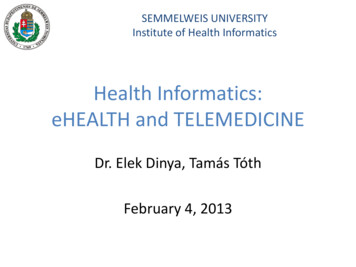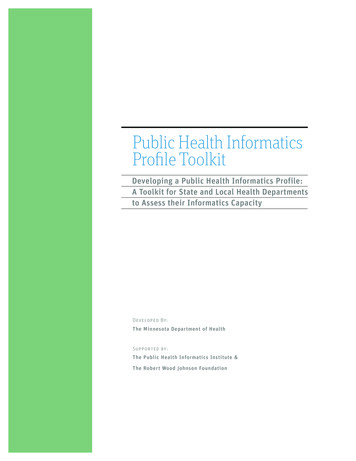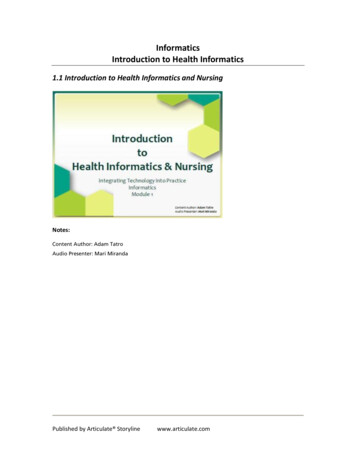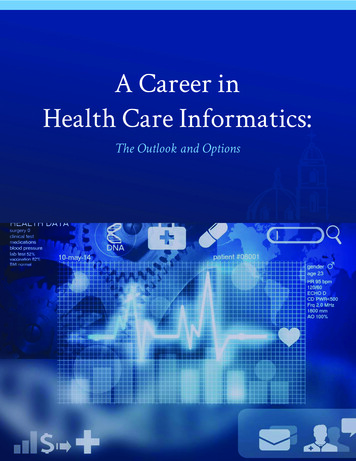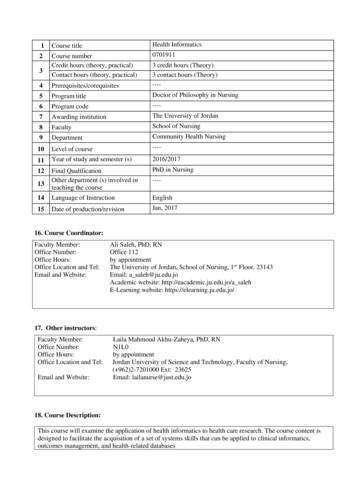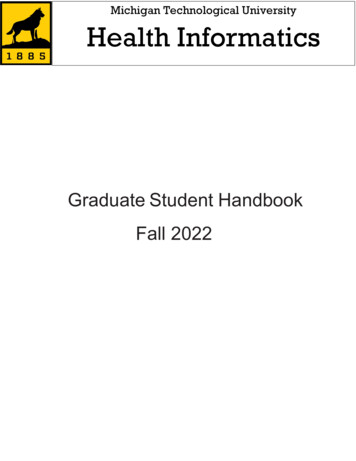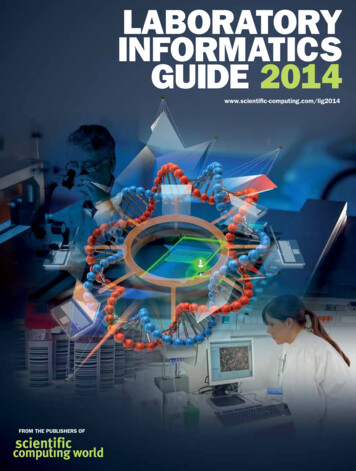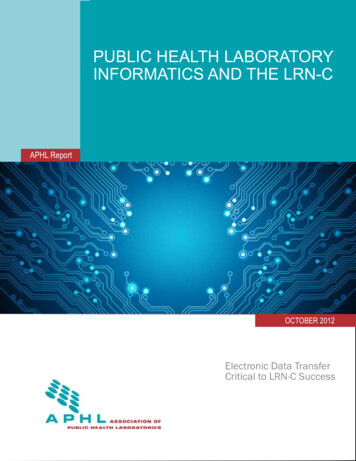
Transcription
PUBLIC HEALTH LABORATORYINFORMATICS AND THE LRN-CAPHL ReportOCTOBER 2012Electronic Data TransferCritical to LRN-C SuccessPublic Health Laboratory Informatics and the LRN-C1
The Association of Public Health Laboratories (APHL) is a national non-profit organization dedicatedto working with members to strengthen governmental laboratories that perform testing of public healthsignificance. By promoting effective programs and public policy, APHL strives to provide memberlaboratories with the resources and infrastructure needed to protect the health of US residents and toprevent and control disease globally.2 Association of Public Health Laboratories
Table of ContentsExecutive Summary.4Introduction.5Gaps.7Bridges.11A Laboratory-Wide “Sub” Network.13Automated Data Flow.14Informatics Competencies and the Laboratory.16Policies and Practices.17MOU Provisions.18Standardized Electronic Data Deliverable.19Conclusion.21Appendix 1: LRN-C Informatics Survey Results .23Appendix 2: APHL Environmental Electronic Data Deliverable.27Public Health Laboratory Informatics and the LRN-C3
Executive SummaryInformatics is a critical component not only of public health laboratory operations, but also the success of the Chemical Laboratory Response Network (LRN-C).At the October 2011 Level 1 LRN-C meeting, attendees discussed barriers to integrating laboratory information management systems (LIMS) with LRN-C reporting systems. Topics covered instrumentation output, data exchange, lackof IT support and interfering state IT requirements.APHL, as the national membership association representing public health laboratories (PHLs), saw an opportunity toassist this group in understanding, navigating and sending electronicdata to the LRN-C. Experience with PHLIP (Public Health LaboratoryExample of an LRN-C LIMSInformatics Project)1 and LIMSi2 positions APHL to meet the needs ofNetworking Implementationboth members and CDC.Workaround:One PHL with instruments interfaced toits LIMS reported their IT departmentrequired networked computers to “timeout” on a frequent basis. Since suchnetworked computers control multipleinstruments and require regular chemist interaction, this timing out compromised analytical activities. As an example of ingenuity and resourcefulnessin the wake of calamity, the laboratorypurchased many shaker tables andplaced computer mice on these tables.Another state experienced the sameproblems, but was able to find a USBattachment to the mouse that alsokeeps the mouse MouseJiggler/1271126.aspxInformation gathering occurred via visit, interviews, a detailed survey,conference calls, and interactions at the spring 2012 LRN-C technicalconference. Research identified both gaps and bridges within level1 and level 2 LRN-C laboratories’ informatics capabilities. The gapsincluded barriers to (a) LIMS implementations, (b) integration of laboratory instruments and collection devices, and (c) automated deliveryof LRN-C data to the Centers for Disease Control (CDC). The bridgeshighlight success stories and potential solutions drawn from real-lifeexperiences.This paper discusses gaps and bridges associated with improving theflow of laboratory data from analytical instrumentation all the wayto decision makers during a chemical threat incident. The audienceincludes public health laboratory directors, APHL and CDC.Overall, findings reinforce that LIMS implementations and interoperable data exchange depend upon appropriate resources (both fundingand staff), as well as competencies. However, other issues remainrelevant, such as: provision of information technology (IT) services inan age of consolidation, networking, security, and laboratory participation in IT management. Recommendations for laboratories include:1.2.3.4.Use a laboratory-wide “sub” network within the larger state or local IT-networked domain.Automate data flow within the laboratory.Develop and maintain the necessary informatics competencies within the laboratory.Implement policies and practices to promote improved communication and service-level supportbetween the laboratory and IT authority.5. Configure your LIMS to adopt standardized electronic data outputs.CDC can help laboratories by embracing recommendation number five and encouraging states to adopt a single,standardized electronic data deliverable (EDD), preferably the APHL EDD. This would lead to standardization not justwithin LRN-C, but also with EPA’s emergency response network and hopefully other federal networks moving ics/collaborations/phlip/Pages/default.aspx4 Association of Public Health Laboratories
IntroductionAt the October 24-27, 2011 CDC LRN-C technical meeting in St. Paul Minnesota, staff from LRN-C level 1 laboratoriesas well as some level 2 laboratories met for roundtable discussions. Attendees discussed a range of issues regardingbarriers to the successful integration of LIMS with LRN-C, covering instrumentation, data exchange, lack of IT supportand interfering state IT requirements.Attendees noted that LIMS implementations and interoperable data exchange between networked LRN-C laboratories depends upon appropriate funding, and staff with necessary competencies. However, other issues such as provision of IT services in the age of consolidation, networking, security, and laboratory participation in IT managementalso remain very relevant. Most agreed that informatics serves a critical component both of public health laboratoryoperations and of the delivery of services necessary for success with the LRN-C.The success of the LRN-C involves the ability of public health laboratories to collect data locally and to send this datato CDC. Electronic transfer of PHL data to CDC can occur in three ways:1. Instrument to CDC: Laboratory data can go directly and securely from the instrument to CDC via Results Messenger (RM). This option is perhaps the least complex option, as laboratories only provide instrument results. Caseinformation and demographics associated with the specimen are stored at a CDC-central LIMS. The disadvantagesassociated with this option include: not storing demographics and metadata in the local LIMS makes this data unavailable to the testinglaboratory or local PH authority;3not encouraging automatic interfacing between instruments and the local LIMS, which reduces transcription errors and improves turnaround times; andnot utilizing a standardized electronic data deliverable.42. PHL LIMS to CDC: In this case, instrument data is entered into the PHL LIMS, and the LIMS manages the delivery of data to Results Messenger. In the most automated case, instruments electronically interface directly to theLIMS, and the LIMS automates the secure delivery of data to CDC via Results Messenger. While this route may notinclude specimen case information and demographics, this option offers advantages: serves as a first step in the process of automating data collection and delivery;allows the inclusion of accessioning and metadata with analytical results reporting; andcan include multiple electronic data delivery formats.2The Laboratory Information Management Systems Integration (LIMSi) project supports ongoing efforts to optimize information flow and systeminteroperability between CDC and participating LRN facilities. The objective of the LIMSi program is to leverage the LIMS capabilities existing atLRN facilities to support electronic data exchange among LRN partners using Public Health Information Network (PHIN) standards. Through thesuccess of the LIMSi initiative, participating LRN laboratories are able to maximize their IT capabilities and fully leverage the benefits of their investments. In addition, LRN laboratories can achieve PHIN interoperability, ultimately enhancing the LRN’s capability to manage data in responseto a public health emergency.3During a large-scale incident, or even a local event managed by a local public health agency, a PHL may need to operate independently of a centralized CDC system. The PHL must include demographic and metadata in reporting and also be able to share this data with the local PH authority.Under method #1, sharing this data locally may require unique electronic or even paper reports.4The report consists of an excel spreadsheet with only analytical data that may not be understood locally.Public Health Laboratory Informatics and the LRN-C5
3. LIMSi: Utilizes the LIMS to automate the data exchange and looks to the future with a more standardized automated delivery of data. Advantages include: a more standardized approach to electronic data delivery that is more consistent with other public healthdata delivery, such as data messaging (e.g. HL7), vocabulary (e.g. codes, semantics), and transport (e.g.PHINMS)near-true, machine-to-machine data exchange potentially in real-time, with the ability to exchange datainteroperably5potential future use of electronic test orders and resultsprovides many of the features currently existing in LRN-Breduces (or eliminates) double-data entry into Results Messengerprovides improved data volume and accuracy during an eventbuilds on a laboratory’s own systems and workflowleverages system automation, such as instrument interface to LIMSreduces training timefacilitates interoperability with other public health partners.While LIMSi offers the best option for PHLs to automate electronic data delivery and interoperability, it does presenta significant challenge for some labs, which must configure their LIMS to ensure that the appropriate data elementsand corresponding vocabulary will support messaging requirements.The goal of this document remains to assist LRN-C labs in understanding, navigating and accomplishing the task of sending electronic data directly from instruments, through their LIMS, to CDC. This paperbreaks down into two major sections: gaps and bridges. ‘Gaps’ identifies barriers to successful LIMS implementations, barriers to successful integration of laboratory instruments and collection devices, and barriers to automateddelivery of LRN-C data to CDC and partners. ‘Bridges’ represents potential solutions based on success stories fromreal LRN-C laboratories. Sources of information include: A comprehensive “LRN-C Informatics Survey” sent via Survey Monkey on Feb 28th 2012 to Level1 and Level 2 LRN-C laboratories; A presentation and discussion at the LRN-C Technical Conference on April 3rd 2012 entitled:“Informatics Gaps and Bridges, A Recent LRN-C Survey”; An on-site visit to a Level 1 LRN-C laboratory to meet laboratorians, IT and informatics specialists; Seven conference calls with individual state laboratory and informatics teams; Discussions with APHL Environmental Health Committee, Environmental Laboratory Subcommittee,and Informatics Committee members; Discussions with CDC LIMSi staff and contractors; Individual discussions with PHL Directors at the 2012 APHL annual meeting in Seattle.Overall recommendations for LRN-C laboratories fall into thefollowing categories, detailed below in ‘Bridges’:1. Use a laboratory-wide “sub” network within the largerstate or local IT-networked domain.2. Automate data flow within the laboratory.3. Develop and maintain the necessary informatics compe-tencies within the laboratory.4. Implement policies and practices to promote improvedcommunication and service-level supportbetween the laboratory and IT authority.5. Configure the LIMS to adopt standardized electronic dataoutputs.5Interoperability refers to the ability of two or more systems or components to exchange information and to use the information that has beenexchanged.6 Association of Public Health Laboratories
GapsAPHL sent the 13-question “LRN-C Informatics Survey” via Survey Monkey on Feb 28, 2012 to Level 1 and Level 2LRN-C scientists and project managers. Prior to sending, the APHL Environmental Health Committee and the Environmental Laboratory Subcommittee pilot-tested the survey instrument.After de-duplicating responses from the same entities, data from 48 labs were evaluated, representing some 96% ofthose surveyed. Appendix 1 tabulates the complete results. The following summarizes the findings:1. Thirty percent (30%) of respondents stated that instrument computers are networked and mustcomply with their IT network standards. These laboratories already achieved integration between their instruments and LIMS; but that means 70% of respondents have not done this yet. Comments included: “We have encountered instrument manufacturers who prohibited us from having anti-virussoftware on their workstation. This is an issue for computers that need to be networked.” “We tried [to network our instruments] initially, but every time IT worked on our system itcrashed. Right now, we have ‘sneakernet’.7” “Our computers are not allowed to be on the network, as they use "third-party" software thatour department won't support. Our IT group will also only support Windows 7 machines.Many of our instrument computers are still running XP, as the vendors have yet to release asoftware package for Windows 7.” “Definitely a sneakernet, and it works very well. We have Excel spreadsheets that we can cut andpaste results into for inputting data to RM, and have had no significant problems with dataentry, review and submission. This way, we can avoid the LIMS.”2. Sixty-four percent (64%) of laboratories reported that IT networking requirements compromise theirinstrument computer functions. Comments included: “We have a separate instrument network server for secure back-up [it is] local to the PHL and does notcomply with IT standards. By the same token, it does not allow internet download, orreach-back from the instrument vendors.” “Laboratorians do not generally have administrative rights to laboratory computers. They can,under a maintenance mode, install updates as necessary.” “Our instrument computers are not networked to avoid having conflicts with IT policies.” “We have the capability of networking our instruments, but when we initially tried to, the GC/MS operating system did not work correctly. We have not attempted to try since!” “50% of the instrument computers are on the network. As the computers age, they no longermeet the network requirements. Occasionally, the laboratory staff will have to request administratorrights to the instrument computers. If there is a problem with the computer, the servicetechnicians voice their conern of the computer being on the department's network due to allthe updates, patches, etc. that is pushed out to all networked computers.” “IT can restart all computers as they see fit. This means that runs over a weekend can bestopped by IT.” “Our PCs on the network time-out.” “We used to have a ‘lab net’, but IT got wind of that and now it’s back to sneakernet. However,IT admin is in flux, and there is hope that we can re-establish a lab sub net.” “We run macros on our data from the instrument computers to convert them into a formatsuitable for upload to RM. This is then copied onto an encrypted USB drive provided by the ITgroup. This USB drive doesn't work with a number of computers, as the encryption seems tohave a conflict with the encryption on the hard drives. This is the only way we are ‘officially’able to upload data.”6LRN-C LIMS that are not configured to mirror the vocabulary mapping established with LRN-C may face significant validation challenges as theyattempt integrated messaging with CDC/LRN applications.Public Health Laboratory Informatics and the LRN-C7
3. Twenty-three percent (23%) stated that their LIMS vendor or developer provides workgroups to assure LIMS support for their clinical chemistry laboratory. Comments suggested “that laboratorians arenot aware of vendor/developer support or team activities.”4. Thirty-nine percent (39%) stated that their LRN-C laboratory has a modern LIMS capable of managing and tracking clinical chemical laboratory activities. Comments included: “Technically, we [have a modern LIMS], but the reality is that Chemistry's LIMS differs fromMicros', and ours is not what I would call robust.” “Our LIMS can do this, but as chemical terrorism does not receive ‘routine’ samples, we are laston the list for any integration into LIMS and any interfacing. It's taken to this past month to getsome of our methods into LIMS and its just manual data entry and verification, only becausewe did a small-scale biomonitoring pilot.” “Our present LIMS can manage and track samples, but nothing else. When developing therequirements for the new LIMS, the 16 business practices above were included.”8 “Yes to most, but note that currently the chemical threat program is not utilizing the LIMS.” “We accession, track, and designate as completed our clinical chemical samples, including PTs.However, none of our instruments are interfaced with the LIMS - this is by my (and mygroup's) intent.”5. Fifty-two percent (52%) reported that their LIMS provides or supports data capture utilities (or interfaces) to automate the delivery of clinical chemistry instrument data to their LIMS. Comments included: “Currently, only our lab's ICP-MS instruments are interfaced. Our lab will interface our remaininginstrumentation as funding becomes available and as the LRN-C tests are configured within the LIMS.” “All other laboratory instrumentation is prioritized above CT (no routine samples); there is thepossibility to do so, but only if funding holds out and once all of the other areas are interfaced.” “The LIMS data capture utilities are not implemented for LRN-C activities.” “Any data capture utilities have to be configured for each specific instrument, even if they arethe same type of instrument from the same manufacturer. The vendor (for the most part) has to beinvolved in the creation of the DCU.” “Yes, but it is considered customization and must be paid for.” “Not as far as I am aware unless you mean excel format upload, since we have to sneakernet allour data over to the Network side.” “The LRN-C lab does not use a LIMS system, but this support is available for other groups that do.” “The functionality is there, but because of ‘uber’ IT issues we load data from the instrument toa USB drive, then to the LIMS for analysis.6. Thirty-five percent (35%) stated that their LRN-C LIMS provides the capability to automaticallyreview their clinical analytical data, associated quality control data, and tracking information prior toreporting out of the laboratory. Comments included: “Sort of, but not really. We can see QC data and analytical data, but not tracking information orfinal reports. We do manually review the data; there is no automatic QC evaluation.” “These capabilities are not implemented for LRN-C activities.” “This is in the deliverables for the new LIMS.” “The LRN-C lab does not use a LIMS system, but this support is available for other groups thathave a LIMS.” “The quality control would be done on instrument PC as the LIMS do not have a QC module.”7Sneakernet is an informal term describing the transfer of electronic information, especially computer files, by physically moving removable mediasuch as magnetic tape, floppy disks, compact discs, USB flash drives, or external hard drives from one computer to another. This is usually in lieuof transferring the information over a computer network. ementslims.aspx8 Association of Public Health Laboratories
7. Sixty-two percent (62%) stated that their LIMS is capable of storing instrument results and qualitycontrol data. Comments included: “Electronic data can be reported in the form of ASCII flat files. We do not do clinical data on this LIMS.” “Our LIMS is flexible enough to accommodate those features though we have not fully implemented them.” “Yes, electronic data deliverable capability exists, but [it is] not used for the chemical threat program. [Weneed] guidance from CDC on format.” “This is in the deliverables for the new LIMS.” “Features are not functioning at the present time. They were built in originally, but there are issues.” “This applies only to LRN-B testing and other biological clinical testing performed in the laboratory.Currently, our LRN-C and environmental testing is not in a LIMS.”8. Twenty-four (24%) stated that their LIMS is able to automate electronic data exchange with theLRN-C and send required data elements/results directly to Result Messenger (RM). Comments included: “Capability is in development.”“Data is manually entered into LIMS, and manually entered from LIMS to RM.”“I do not believe that CDC's Results Messenger has the ability to directly accept an EDD from a LIMS.”“At least not without a lot of investment in customization.”“This is in the deliverables for the new LIMS.”“Our LIMS may be able to. We have not tried to send data to Results Messenger at this time.”“Steps are in place that facilitate upload into RM, but it isn't automatic. This is the goal we are workingtowards.” “We use Excel for most all of our work and avoid the LIMS.” “Currently, our LIMS generates an Excel file which has to be copied into a new Excel file to be uploaded into[Results] Messenger.”9.This is a multi-part question regarding the IT department support of the PHL:a. 41% stated that their IT department can provide 24 x7 IT staff available for emergency support of theirlaboratory.b. 49% stated that there is partnering with the IT department and laboratory staff to manage vendors.c. 51% stated that there is dedicated application-level LIMS support.d. 20% stated that there are defined partnerships with high visibility agencies within their stateand/or local government to assure that the laboratory has a role in IT governance.e. 59% stated that there is oversight and project management at the laboratory level.Comments included: “Our state ‘IT department’ provides none of these features without extreme costs. Our internalIT staff provides instrumental and LIMS administration and support.” “There is a disconnect between the people that work directly with us in the IT department and theirsuperiors.” “We have one person to support our LIMS system. We have managerial rights in the LIMS, but notadministrative rights.” “We have a part-time IT application specialist who is available on-site (perhaps two days of the week) andon-line (3 days/wk).” “We have our own LIMS Administrator (a microbiologist by training). IT does not interactwith LIMS if they can avoid it as it is not ‘their’ application.” “They do not work to facilitate the lab needs but to maintain the state requirements.” “Funding has been extremely difficult for dedicated application level LIMS support.” “They are on grant money. Last year, funding for the next contract year only became available theday before their current contract ended.”Public Health Laboratory Informatics and the LRN-C9
10. Twenty-three percent (23%) state that their laboratory leadership has a signed memorandum ofagreement (MOU) or a service level agreement (SLA) with their jurisdiction’s IT leadership that specifically defines support for IT functions. Comments included: “Our state ‘IT Department’ does not sign MOUs or SLAs with other state agencies under mostcircumstances.” “Not to my knowledge. If one is there, it is not being wisely used, in my opinion.” “Because of budget considerations, IT management is being moved to another Department of the stategovernment. It is unknown at this time what form service agreements will take in the near future.” “Not sure.” “The IT support comes within the agency from another group.”11. Fifty-four percent (54%) believe that their LRN-C laboratory will have access to LRN-B laboratory modern broker tools (e.g. Orion Rhapsody, MIRTH etc.) and staff trained to use these tools to mapLIMS data elements, provide vocabulary harmonization, and transport messages. Comments included: “LRN-C development is more complex than LRN-B.”10 Association of Public Health Laboratories
BridgesThe same survey identified many positive activities and examples of innovative bridging options related to successful LRN-Cinformatics practices. Examples include:1. Eighty percent (80%) of respondents reported that laboratorians have the necessary independence andsupport to assure instrument computers can operate according to the instrument manufacturers’ needs.2. Ninety percent (90%) reported that laboratorians have authority to work directly with instrument vendors tomaintain instrument computers. Comments included: “Our instruments are on the network, however, updates are first tested on a test machine anddownloads occur at a time determined by the bench chemist. Because the lab is secure, timing out is notnecessary. Our IT group works with us.”3. Eighty (80%) reported that instrument computers can utilize the operating systems supported by the instrument manufacturer.4. Sixty-nine percent (69%) reported that laboratorians have administrative rights to the laboratory to managekey LIMS operations.5. Other positive comments provide examples of individual successes (but do not represent majority statements): “This survey came at the right time and helped us refine the goals for our IT system for LRN-C. Thanks.” “All our LRN-C instruments are networked internally within the lab. We would be able to put LIMS on that network.” “Our laboratory implements a buffer network. Primary Network Interface Controller (NIC) connectsto state network with 2nd NIC. Creates a private network between the buffer network and the instrument computer.Communication is limited within the private network.” “Our Instrument Network at the PHL is separate from the DOH Network. This prevents the automaticupgrades that cause the older instrument software to crash, and allows maintenance of thesoftware systems that were sold with, and work with, the instruments. Files are transferred be tweenthe two by mobile memory device.” “Our IT department is part of the laboratory.” “IT and the PHL are separate departments but are both part of the DOH and are both under the direction ofthe state health officer. Both department directors are members of the governance council.” “We have our own LIMS Administrator (a microbiologist by training). IT does not interact with LIMSif they can avoid it as it is not ‘their’ application. Our IT staff provides technical support on computerhardware and some software issues. Laboratory staff routinely works to resolve software issues.” “Our laboratory is in the process of installing a new LIMS with advanced capabilities to meet needs described inthis survey.” “Electronic data messages can be released through Orion Rhapsody, where it is parsed to the correct public healthpartners.” “The LIMS vendor has an annual meeting.” “Data is automatically uploaded to our LIMS from our instruments.Thematically, research and discussions with states suggests that successful bridges fall into the following five areas:1. Use of an independent laboratory-wide “sub” network within the larger state or local IT-networkeddomain.2. Automate data flow within the laboratory.3. Develop and maintain the necessary informatics competencies within the laboratory.4. Implement policies and practices to promote improved communication and service-level supportbetween the laboratory and IT authority.5. Configure your LIMS to adopt standardized electronic data outputs.Public Health Laboratory Informatics and the LRN-C11
A Laboratory-Wide “Sub” NetworkSeveral states indicated that LRN-C implementation benefits from the use of a laboratory-wide “sub” network withinthe larger domain of the state or local IT authority. For many, this means placement of both instruments, and interfaces to their LIMS, on a network domain separate from the jurisdiction-wide area network domain. In some cases,the laboratory’s LRN-C and LRN-B have similar implementation paths to automatically collect and transmit data electronically. The use of sub networks allows the laboratory to take ownership of an important component of IT services.Instruments and LIMS (which to many is an extension of analytical processes and instruments) remain in an areathat many IT departments have little interest in physically attending.To better understand this idea of separate network domains for the laboratory and IT authority, APHL interviewed several laboratories. Two state labs were chosen as examples for this paper because of their successful integration oflaboratory and IT, and because of their systematic approach to n
"Informatics Gaps and Bridges, A Recent LRN-C Survey"; An on-site visit to a Level 1 LRN-C laboratory to meet laboratorians, IT and informatics specialists; Seven conference calls with individual state laboratory and informatics teams; Discussions with APHL Environmental Health Committee, Environmental Laboratory Subcommittee,
